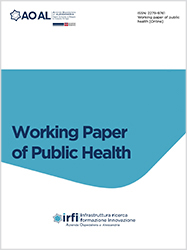From Emergency Department to clinic center: management of patients with heart failure with reduced ejection fraction
All claims expressed in this article are solely those of the authors and do not necessarily represent those of their affiliated organizations, or those of the publisher, the editors and the reviewers. Any product that may be evaluated in this article or claim that may be made by its manufacturer is not guaranteed or endorsed by the publisher.
Authors
Aims. Primary outcomes - cardiovascular and all-cause mortality evaluation within 1 year in elderly patients enrolled with Angiotensin Receptor Inhibitor (ARNI) and/or Sodium Glucose Co-Transporter Type 2 Inhibitors (SGLT2-i) in an Internal Medicine Department; recurrent hospitalization assessment for acute Heart Failure with Reduced Ejection Fraction (HFrEF); length of hospitalization analysis compared to not-enrolled patients. Secondary endpoints - to identify any parameters predicting the length of hospitalization; safety assessment through the incidence of complications and treatment interruption. Materials and Methods. Prospective observational real-life cohort study that analyzes the recruitment during hospitalization and follow-up 3-6-12 months after discharge. Several clinical parameters were recorded for each patient of any ethnicity, considering a diagnosis of acute HFrEF with NT-proBNP and chest x-ray. Results. The enrolled group (34 patients) showed a hospitalization period lower than the not-enrolled one. The rehospitalizations percentage was inferior to Randomized Clinical Trials (RCTs) for ARNI. Cardiovascular-cause mortality, symptomatic hypotension, and Urinary Tract Infections (UTI) were lower than RCTs data. Age, eGFR, NT-proBNP, Cumulative Illness Rating Scale (CIRS), and severe comorbidities, except for EF, predicted the lengthening of hospitalization. Hypoglycemia wasn’t recorded. Conclusions. ARNI/SGLT2-i are effective and safe in elderly patients. Comorbidities and bio-humoral features influence HFrEF and quality of life. The future aim is to confirm the results obtained so far.
Dirigente Medico I livello UO Medicina Interna II
Dirigente Medico I livello UO Medicina Interna II
Dirigente Medico I livello UO Medicina Interna II
Dirigente Medico II livello UO Medicina Interna II
Dirigente Medico II livello UO Medicina Interna
How to Cite

This work is licensed under a Creative Commons Attribution-NonCommercial 4.0 International License.







